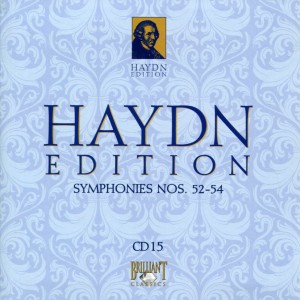 I was all settled into my usual table at Panera, ready to watch the sun rise, when I discovered I couldn’t play anything. iTunes wouldn’t play. I couldn’t stream from the ‘Net. Hmm.
I was all settled into my usual table at Panera, ready to watch the sun rise, when I discovered I couldn’t play anything. iTunes wouldn’t play. I couldn’t stream from the ‘Net. Hmm.
I pushed (and re-pushed) buttons. I Googled “Why won’t my MacBook Pro play music or stream audio files?”
Alas. To no avail.
So I shut everything down and restarted my computer.
It worked. Whew.
I am now being serenaded by the dulcet sounds of a Franz Joseph Haydn composition. Symphony No. 52 in C Minor, one of the last of Haydn’s Sturm und Drang-era symphonies. This one was composed in 1771 or 1772. Haydn was 39 or 40.
According to its entry on Wiki,
The symphony has several distinct features. The first movement, written in Sonata-Allegro form, establishes a contrast between an agitated and forte opening theme in C minor, and a lyrical and piano second theme in the relative major (E-flat). Somewhat unusually, Haydn presents the second theme twice with transitional material in between its appearances.As with his Symphony No. 45, the movement employs deceptive progressions in both the exposition (mm. 36–37) and recapitulation (mm. 130-31). The “anger and vehemence” established by the minor mode of the symphony surpasses Haydn’s earlier minor key symphonic efforts.
I don’t know if that’s true or not (I’m not a musicologist, remember?). But what I do know is this: Symphony No. 52 is a ponderous, somewhat somber, serious symphony. There’s very little bouncy and intricate here. It’s stately to the point of staid.
Symphony No. 53 in D “L’Imperiale” begins with a burst of energy in Movement I (“Largo maestoso – Vivace”), but then returns to stately, serious, staid form in Movement II ( “Andante”). It’s a bit livelier than No. 52. But not by much. Here’s what I mean:
Movement I is very nicely composed.
Why is it nicknamed L’Imperiale? Don’t know. According to author Richard Wigmore in his book The Faber Pocket Guide to Haydn, this symphony was “obscurely nicknamed.” Being the “Why?” man that I am, that bugs me. I’ll do more research, offline at another time, and maybe discover why. In the meantime, I’ll have to live with don’t know.
Symphony No. 53 was composed in 1774. Haydn was 42.
Symphony No. 54 in G, the last symphony on Haydn CD 15, was also composed in 1774. It, too, begins with a fanfare, a triumphant burst of instruments that gives way to a stately, ponderous tempo.
I like what Wikipedia has to say about this symphony:
Following a slow introduction, the opening theme of the first movement is stated in octaves by the first horn and the bassoon against a string accompaniment. Interestingly, it is the string accompaniment which is worked in the development.Although the movement is not formally or thematically one of Haydn’s more memorable efforts, it is notable for its advances in orchestration because of the independence of the bassoon from the other bass parts and other sectional specializations such as the use of winds to sustain harmonies while the strings expand on the melodies.
The slow movement is one of Haydn’s most memorable. The movement is in sonata form and opens with a section marked messa di voce and builds up to a cadenza cadence which is followed by a cadenza for solo violin. In the recapitulation, the build-up to the cadenza is intensified and the cadenza is lengthened and expanded to two solo violins.
I must say, each of the three symphonies in today’s selection were noteworthy. I prefer them in reverse order, I think: No. 54, then No. 53, then No. 52.
I am still blown away by the fact that this music was recorded in Esterhazy Palace, Eisenstadt, Austria, where they were composed when Haydn was the court musician of the wealthy Esterhazy family. That gives these recordings and extra special meaning to me, an air of authenticity that is, frankly, unrivaled. If you’re going to play and record Haydn symphonies, why not do it in the very place where he composed them? (For more about the Esterhazy family, see this Wiki entry about the House of Esterhazy.)

Wow, very nice. Thanks for including the video. It’s fun to hear what you’re listening to along with your comments.
You’re the second person who’s mentioned that to me. The problem is this: If I rely on YouTube for content, what happens (a) when the upload is pulled and no longer available on YouTube, and/or (b) I can’t find the exact recording I’m listening to, which means some of what I hear won’t be the same as what people hear. Granted, it’s not going to be off by that much. But dynamics change, recording quality changes, sometimes even instruments change (piano for harpsichord, for example).
Yet, that’s not a bad idea. I may find a YouTube clip for each symphony and add that to my blog.